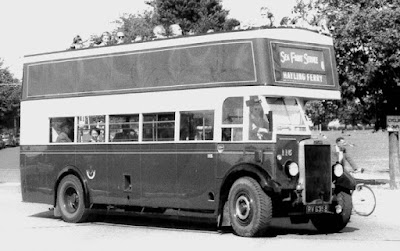Episode 1 - A New Life Proposed
Because of its status as a navy base, Portsmouth was badly battered during WW2. Each dot above is a bomb strike and some of the pictures of destruction are horrific.The above was Kings Road.
So it was that the City Council resolved to achieve two things with the rebuild. Of course new houses were to be provided but, in addition, the opportunity was to be taken to demolish old poor quality housing and workshop areas and provide new roads and new parklands for the recovering city.
So they bought a plot! It was quite a big plot north of Havant.Today's Leigh Park estate runs from the red road lower left to the railway on the right. The land was part of the private estate called, surprisingly, Leigh Park.Part of the former Park at Leigh is now designated as Staunton Country Park.Work on this vast area of Portsmouth "overspill" housing started in earnest in 1947 ...
... and by 1949 it was necessary to do something about Public Transport.
Information was sent to fbb by THREE locals or ex locals explaining the origins and developments of the buses very thoroughly.
Unfortunately, for fbb's brain, one on-line booklet covers Portsmouth Corporation routes whilst the other is all about Southdown services.
And fbb has to try to put them together!
In simple terms, both municipality and company laid claim to a share of the Leigh Park business; Southdown from its base in Havant sought to serve what was a new suburb for their town. Meanwhile Pompey had built the estate for Pompey people who mostly worked in Pompey, so had an equal if not a greater claim to the territory.
Whilst Southdown management philosophy was simple, things were more complicated in Portsmouth. Trams had gone in the late 1930s to be replaced with trolleybuses. Indeed, an occasional visitor in the 1950s would be forgiven for thinking that Portsmouth ONLY ran trolleybuses, so comprehensive was the network.
On the coast there were significant termini at South Parade Pier ...... at Clarence Pier and Old Portsmouth ("Point") ...... and at The Dockyard ...... later known as The Hard and now called Gunwharf Quays (which it isn''t) to claim omnibological allegiance to the thrilling retail experience now available.
It is worth remembering that Portsmouth Harbour Station was, for many a long year, approached via a walkway over the water at high tide and over gloopy mud when the sea went away.The lagoon was filled in to create a bus station (latest version below)!All of the other side of the station was filled in to provide that wonderful shopping experience that we all know and love! It is just a bit different from Seaton!In the north, trolleybuses, like the trams before them, escaped from Portsea Island by crossing the creek. The most northerly terminus was at Cosham on the mainland.Now, a test of readers' observation and public transport acumen (for which medication is available on prescription!). What did is noteworthy about ALL the trolleybus terminus "blobs".
Gottit?
Every one of them has TWO route numbers inscribed therein.
That's because every Portsmouth trolleybus route was numbered unidirectionally; one route number for out of town and one for the run back. It does mean that you need double the number of numbers.
As the inexorable tick of time progressed, new areas of the city needed transport and most of these were served by the dreaded motor bus. But to avoid confusion (?) motor bus routes were lettered; but still with a different letter for each direction. Look at Cosham on the maps above and you will see route AB.
It is a motor bus, innit!
Spookily, all of the bus routes being taken over by Stagecoach were always motor buses.
New Stagecoach 13/14 - Baffins
New Stagecoach 18 - Paulsgrove
Again the area was still being developed in 1957 but ...
New Stagecoach 25 - Hayling Ferry
... the A and B served the expanding housing estates.
The nearest equivalent was a trolleybus to Eastney: but the end bit to Hayling Ferry was the home of the "Sea Front Service" ...... with no route number!
Some might argue that the F and G were closer to the present 25.Maybe?Eastney appears to have moved further eastney!
So what about Leigh Park, we hear our reader cry. We might reasonably expect some lettered motor bus routes.
See the reveal tomorrow.
See the reveal tomorrow.
Next Leigh Park blog : Friday 11th August























No comments:
Post a Comment